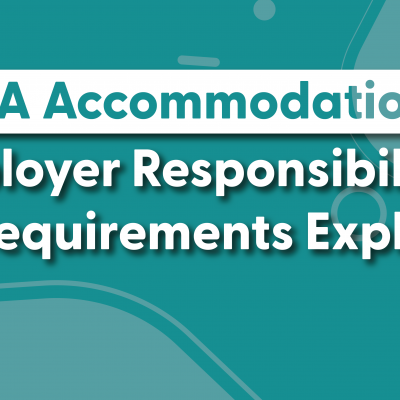It’s no secret that diversity and inclusivity are playing an ever-growing role in ensuring that individuals with disabilities have equal opportunities and access to meaningful employment. At the heart of this mission is the Americans with Disabilities Act (ADA), which before getting into the nitty gritty, exists to prohibit discrimination against individuals with disabilities, and mandates that employers must provide reasonable accommodations to qualified employees or job applicants with disabilities.
As an employer, understanding and fulfilling the responsibilities under the ADA isn’t always crystal clear. Equipping yourself with the knowledge and tools necessary to navigate the intricacies of ADA accommodations with confidence is essential for building a workplace where everyone has the opportunity to contribute their unique talents and skills to help improve the world (or, you know, whatever it is your organization does…).
So you want to make sure you’re adhering to the guidelines set forth by the ADA and also build an inclusive work environment within your organization? That’s super duper, and we’re here to help. Let’s break down the different requirements and responsibilities you have as an employer when it comes to ADA and ADA accommodations:
What the ADA Says About Non-Discrimination
You know how they have those “Caution, the moving walkway is now ending,” warnings at airports and you think to yourself, “Isn’t that obvious? Is this really necessary?” Then you pause for a second and realize they wouldn’t have warnings if people weren’t actually eating dirt on these things. This might be how one might view the ADA needing to spell out that employers must not discriminate against qualified individuals with disabilities.
While this seems like both an obvious and human way to act for most of us, it’s the backbone of the ADA because without this federal protection explicitly put in place for all aspects of employment, including hiring, firing, promotions, job assignments, and compensation, employers would have no recourse for discriminating against those with disabilities. Without this blasting from the federal regulation loudspeaker, employers might do it.
What is Considered an Undue Hardship by the ADA?
The ADA recognizes that while you’re required to provide reasonable accommodations, there are limits to the lengths you are required to go in order to accommodate an employee with a disability. The ADA refers to exceeding these limits as an “Undue Hardship.”
As an employer, the ADA allows you to decline accommodations that would impose significant difficulty or expense on their operations. This provision is intended to strike a balance between the rights of individuals with disabilities and the practical limitations faced by businesses.
Carefully assess the potential burden of an accommodation, considering factors like the organization’s size, resources, and the nature of the accommodation requested. Ultimately, accommodations that would fundamentally alter the nature of the business or result in excessive costs could be deemed as constituting undue hardship under the ADA.
Whenever possible, consult with legal counsel when making a determination of this nature.
What is a Reasonable Accommodation According to the ADA?
Now that we’ve given an overview of non-discrimination and undue hardship, let’s get into what’s required as an employer when it comes to providing reasonable accommodations to qualified employees, or applicants with disabilities.
A reasonable accommodation is a modification or adjustment to the workplace or job that allows qualified individuals with a disability to perform the essential functions of the job. It should be noted that a reasonable accommodation could be a leave of absence. You can view a reasonable accommodation as a custom-tailored superhero cape for employees with disabilities, designed to level the playing field at work by providing practical adjustments or assistance, allowing them to shine in their roles.
What does the ADA Interactive Process Mean?
The ADA interactive process is essentially a two-way discourse between employers and employees with disabilities. It encourages both parties to sit down and discuss potential accommodations in good faith through a structured, deliberate dialogue, akin to a focused discussion about aligning resources with job requirements.
It should be noted that often, part of the interactive process involves the employee submitting a medical inquiry form which (1) confirms that the employee is disabled, as defined by the ADA, and (2) explains the limitations to job functions. This information helps the employee and employer find an appropriate accommodation
The ADA underscores the significance of the interactive process as a serious and essential aspect of accommodating employees with disabilities. The ADA doesn’t outline a specific format, but it does mandate that as an employer you engage in sincere discussions aimed at identifying reasonable accommodations. In essence, it necessitates a comprehensive exchange of information and insights: you’re required to openly share your knowledge of job demands, while employees must disclose their disability-related limitations and accommodation needs.
The interactive process calls for a pragmatic, collaborative approach with a primary goal of arriving at suitable accommodations, to achieve the overarching objective of fostering an inclusive and accessible workplace.
ADA Requirements for the Job Application Process
The ADA isn’t only focused on humans already in your employment. It mandates that the job application process must be fair and accessible to individuals with disabilities as well. As an employer, you’re required to provide reasonable accommodations to ensure that applicants with disabilities have an equal opportunity to participate.
These adjustments may manifest in a variety of ways, such as providing accessible application forms, offering additional time for tests or interviews if needed, or allowing alternative methods of application submission. Discriminating against applicants based on their disabilities is a no-go under the ADA, so ensure that your employment decisions are based on qualifications and merit rather than disability status.
What the ADA says about physical accessibility
Let’s shift gears a bit from Title I of the ADA, which covers employment considerations to Title III, which covers public accommodations and services operated by private entities. The ADA sets forth stringent requirements regarding physical accessibility, insisting that businesses and public facilities be accessible to individuals with disabilities. This encompasses features like ramps, accessible entrances, wider doorways, and accessible restrooms to facilitate mobility for people with disabilities.
Additionally, the ADA mandates that these modifications be made to existing structures whenever “readily achievable” without imposing excessive financial burden, ensuring that accessibility becomes a fundamental aspect of public spaces and workplaces, promoting inclusivity for all.
ADA Rules on the Modification of Policies and Practices
The ADA requires your organization to be both flexible and open-minded to modifying policies and practices to accommodate individuals with disabilities. This means making reasonable changes to policies and procedures to ensure that they do not discriminate against or create barriers for people with disabilities.
Whether it’s adjusting a dress code, modifying work schedules, or providing communication assistance, the ADA encourages your organization’s adaptation to promote equal opportunity and inclusion in employment and public services while still considering the organization’s operational needs. These modifications are essential in ensuring that individuals with disabilities can fully participate and thrive in various aspects of life.
Equal Benefits and Privileges Outlined in the ADA
This is another item that may seem obvious, but the ADA mandates that individuals with disabilities must receive equal benefits and privileges as those without disabilities. Whether it’s access to facilities, participation in programs, social activities, or receiving workplace benefits, individuals with disabilities should not be treated less favorably or denied equal access. The ADA’s core principle is to ensure that people with disabilities have the same opportunities and rights as everyone else, and that certainly includes benefits and privileges.
ADA Accommodation Confidentiality
The ADA stipulates that as an employer you must keep all medical and disability-related information obtained during the accommodation process strictly confidential and kept separate from personnel files. This means limiting access to such information to those who need to know, such as your HR team and the employee’s supervisor, while ensuring that this sensitive information is not shared with other employees.
Maintaining confidentiality is not only a legal requirement but also crucial in respecting the privacy and dignity of individuals with disabilities, and fostering a workplace environment that encourages trust and open communication.
Do ADA Accommodations Prohibit Retaliation?
Oh yeah. Discrimination in the form of retaliation is a major ADA faux pas. The ADA strongly prohibits any form of retaliation against individuals who request or receive ADA accommodations. Taking adverse actions such as demotion, termination, or harassment, in response to accommodation requests or an exercising of ADA rights, is acting in violation of the law.
The law safeguards the rights of employees to make accommodation requests without fear of reprisal, creating a protective shield that encourages individuals to seek the accommodations they need to perform their jobs effectively. It is a crucial aspect of ensuring that the ADA’s principles of equal opportunity and inclusion are upheld in the workplace.
Consequences for ADA Accommodations Non-Compliance
Failure to adhere to ADA accommodation guidelines can have serious consequences for your organization. Non-compliance can lead to costly legal actions, including discrimination lawsuits filed by aggrieved employees or job applicants or the Equal Employment Opportunity Commission (EEOC) itself. These lawsuits can result in significant financial penalties, damages, and legal fees.
Furthermore, non-compliance can damage your organization’s reputation, leading to negative publicity and potential loss of customers and business partners. In addition to legal and reputational risks, failure to provide reasonable accommodations can lead to decreased morale among employees, reduced productivity, and increased turnover.
Prioritizing ADA compliance not only helps you avoid legal troubles but also builds an equitable workplace, which can ultimately benefit your organization by attracting and retaining a diverse and talented workforce.
About Tilt
Tilt is leading the charge in all things leave of absence management through easy-to-use tech and human touch. Since 2017, our proprietary platform and Empathy Warriors have been helping customers make leave not suck by eliminating administrative burdens, keeping companies compliant, and providing a truly positive and supportive leave of absence experience for their people.







